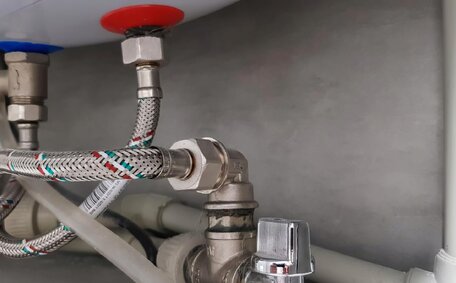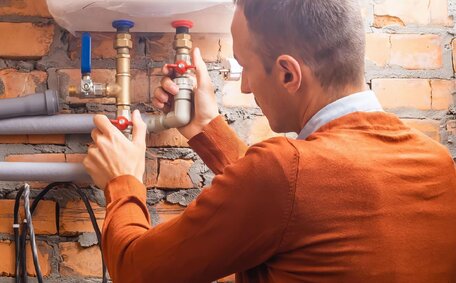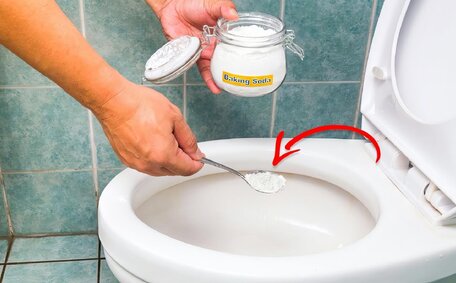Introduction to Hot Water System Thermostats
A heater thermostat, including the lower heating control, is a vital component in your hot water heater that regulates water temperature.
The upper element is engaged by the top thermostat to maintain your water temperature in the tank at the desired level. Hot water systems often feature two heating elements, including a lower heating element, with each regulated by one of the two thermostats.
Functional thermostats play a crucial role in maintaining the efficiency and safety of your water heater, similar to an anode rod. As limit switches and reset buttons, they prevent overheating of the tank, essential for safe operation of the water system. Faulty thermostat operations that fail to disengage heating elements can lead to dangerous overheating.
Understanding how to test water heater thermostat is an important maintenance task that can reveal problems in the water tank before they cause expensive damage or unsafe conditions. Follow these step-by-step instructions to check if your thermostats are working correctly or need to be replaced.
Safety First: Turning Off Power Before Testing
To ensure safety during maintenance, disconnect the power supply to your electric water heater completely before commencing any work.
According to recommendations from the U.S. Consumer Product Safety Commission, you should turn power off at the circuit breaker that supplies power to the water heater before accessing internal components. Confirm that all circuit breakers connected to the water heater are switched off to ensure complete disconnection.
Verify the power is off by using a non-contact voltage tester on the thermostat terminals. Do not touch any internal component with your hands until you have verified there is no chance of electrocution.
After confirming the absence of power, you can begin testing the thermostat. Safety should remain the top focus before, during and after any hot water system maintenance.
Gathering Necessary Tools and Materials
To test water system thermostats, you’ll need to gather some basic tools and materials before getting started:
- Multimeter - This is the most essential item needed to check electrical continuity and resistance.
- Screwdrivers - Both a Phillips and flathead screwdriver will be necessary to open access panels.
- Gloves & Safety Glasses - Wear protective equipment when working near electrical components.
- Voltage Tester - Use a non-contact voltage tester to confirm power is off.
- Thermometer - Double check the temperature of your water with a thermometer after testing.
Armed with these essential tools, you can systematically carry out a thorough inspection of your water heater thermostat. The readings your multimeter should produce will be paramount in ascertaining the necessity for any replacement.
Accessing the Thermostat and Wiring
Begin servicing the electric water heater by locating the access panel for the thermostat and wiring. Most models feature a small, detachable access panel either at the top of the tank or on the side. Use your screwdriver to remove the screws holding the panel in place.
Upon panel removal, examine the central thermostat and its adjacent upper heating element. Carefully remove the plastic cover near the lower element to reveal the thermostat’s wiring terminals. Take care to avoid damaging the wires.
Observe that the thermostat is held in place by two screws and possesses 3 to 4 push-in wire terminals. Make note of where each wire connects to the element thermostat. Power wires are connected to the common terminal and each thermostat’s designated terminal.
Once the thermostat wiring is visible, you can begin diagnostics using your multimeter. Ensure you reattach the plastic cover and access panel after completing the multimeter tests.
Testing the Thermostat for Continuity
A pivotal step in how test water heater thermostats is the continuity check. Set your multimeter to the appropriate continuity setting for thermostat testing, which beeps upon detecting a closed circuit.
To test your gas or electric water heater, position the multimeter’s red probe on one of the thermostat’s wire terminals. Next, touch each remaining terminal with the black probe, using one lead at a time to ascertain the thermostat’s functionality. If you don’t get a beep from the device, it might signal an underlying issue.
An absence of a beep or reading could indicate a break in continuity or a possible short circuit within the thermostat. This likely indicates the need water heater thermostat replacement due to a fault detected. Water heater element testing each connection this way allows you to pinpoint any problem areas.
As another check, you can also test the resistance between the terminals. It should give a reading of zero ohms resistance, indicating continuity. The reading should be zero; any higher means there is resistance in the circuit, so the thermostat would need replacing.
Testing Resistance Levels with a Multimeter
Utilise a digital multimeter to measure the readings on the top and bottom terminals, determining the thermostat’s condition. Adjust water heater temperature settings as needed; OSHA recommends not exceeding 49°C to prevent scalding.
Switch the multimeter to resistance mode, denoted by the Ω symbol, and attach a lead to the thermostat’s probe terminal. Next, Position the probe against the terminals for both the upper and lower thermostats, testing them in turn.
Expect to see readings near 3 ohms for gas water heaters or between 9-17 ohms for electric models. Readings that diverge considerably from these norms suggest the thermostat may require replacement.
Testing both upper and lower thermostat resistance gives a complete picture of how heat regulation is functioning. If just one element shows abnormal readings while the other is normal, you may need to address a faulty hot water element or replace the thermostat.
Interpreting Test Results
Once you have completed testing the thermostat for continuity and resistance, it’s time to test lower components’ results to determine if replacement is necessary to keep your water heater working correctly. Here is how to test your water heater thermostat readings effectively:
Continuity Test
- A beep sound suggests the thermostat circuit is complete, signalling continuity.
- No beep sound - Indicates a break in continuity, thermostat should be replaced.
Resistance Test
- For gas water heaters, readings should be around 3 ohms; if they differ, consider replacement.
- Electric water heaters:
- Upper thermostat - Acceptable range is 9-17 ohms.
- Lower thermostat - Acceptable range is 9-17 ohms.
- Readings significantly higher or lower than expected indicate a malfunctioning thermostat that likely requires replacement.
Employ these criteria to determine if the thermostat in your hot water system is operational or needs exchanging. If the problems persist, it’s wise to seek the expertise of a professional plumber.
Troubleshooting Common Testing Issues
When testing your hot water system thermostat, you may run into some common issues that prevent accurate readings or cause problems during the process. Here are some of the most frequent testing troubles and how to resolve them:
Unexpected Readings
If your multimeter is showing readings that seem too high, too low, or inconsistent, there are a few things to check:
- Ensure the multimeter is correctly set by verifying whether it’s measuring continuity or resistance accurately.
- Inspect all wire connections - a loose wire can cause inaccurate results.
- Try testing with a different metre - rule out a faulty multimeter.
- Repeat testing more than once - confirm the readings are consistently unusual.
No Reading/No Response
If you are unable to get any reading or response when testing, try these steps:
- Make certain power is definitely off - even a minute voltage can impact readings.
- Check that plastic terminal covers are removed.
- Inspect for damaged wires, loose connections or corrosion.
- Consider thermostat may be non-functional and need replacement.
Carefully working through these common testing issues can help you accurately troubleshoot your hot water system’s thermostat. Don’t hesitate to call a professional if problems persist after multiple attempts.
Deciding Whether to Repair or Replace
When testing reveals a faulty thermostat, you must decide whether to repair it or replace it entirely. Factors to consider include:
- Cost - Replacement thermostats range from $20-50 while repairs average $100+ in labour fees.
- Age - For water heaters past the 10-year mark, replacing may be more prudent than fixing an obsolete model.
- Severity of issues - If tests show complete failure with no continuity, replacement is likely needed. However, small variations in resistance might be fixable.
In general, if your current thermostat is still fairly new and issues appear relatively minor, repair may be worthwhile. But for older units or those failing continuity tests, replacement is probably the wiser choice.
Consult a professional if uncertain whether your water heater’s thermostat is set too high or low, or if problems necessitate repair versus complete replacement.
Reassembling and Performing Safety Checks
After testing, it’s imperative to reassemble the hot water system correctly and conduct safety checks before re-energising.
Re-affix the plastic shield just above the thermostat’s circuitry, confirming everything is snug; a crucial step, making sure to turn off power at the water heater for safety. Carefully inspect any disturbed wires during testing to ensure their push-in connections are still tight and fully inserted. Wires should be neat and tidy, not loose.
Verify access panels have been replaced securely over the thermostat, as you need check each closure using all screws. Give panels a firm tug to confirm they will not come loose.
Inspect the area surrounding the water heater, ensuring all tools and materials are tidily stored to avoid hazards. Ensure that the area is free from any potential tripping or fire risks prior to restoring power.
Once assured of safety checks’ completion, you can restore power, closely monitoring hot water all through your heating system as the temperature stabilises. Re-test near the thermostat with your non-contact voltage tester to make sure the power is back on and the system is operational.
With power restored, Lastly, assess the water flow and confirm that the hot water system delivers a consistent temperature. Turn on a hot tap and verify hot water from your water heaters flows properly all the way through, reaching an appropriate temperature around 49 degrees Celsius. Contact a professional plumber immediately if symptoms like no hot water persist.






